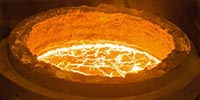Refractory industries
The properties of alumina in various refractory industries have been a vital issue since the 1990s. Many kinds of research and developments in this field have been made during the past 20 years. The high demand that we have in the worldwide iron and steel market has led to the application of alumina for the production of refractories.
What justifies the application of alumina in the refractory industry is the excellent and special properties that this ceramic powder offers in the refractory body and mass. The most crucial properties of alumina structures are introduced and mentioned as follows:
- High thermal resistance
- Great thermal shock
- High abrasion resistance
- High hardness
- Creating rheological properties in refractory materials
- Excellent thermal stability
- Corrosion resistance
- Electrical and thermal insulation
- Suitable sintering
All these special properties make this strategic material to be applied in a wide range of various industries such as iron and steel, petrochemicals, cement, non-ferrous metals, glass, and other industries.
These materials are normally applied widely in industries such as steel, cement, glass, and non-ferrous metals. The application of refractory materials has two important reasons: 1) Making sure that the process will be completed correctly and 2) Enhancing the quality of produced products.
A typical aggregates forms an area around the aggregates additives. Skeletal aggregates make materials and make the major portion of refractory materials that provide resistance to abrasion and corrosion at high temperatures. The matrix or substrate is combined with small materials such as alumina, cement, and micro silica and acts as a binder between these. Hence, the role of the matrix or substrate in enhancing and achieving very high performance is absolutely essential, and we really should care about this part.







